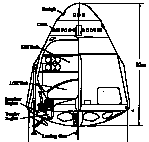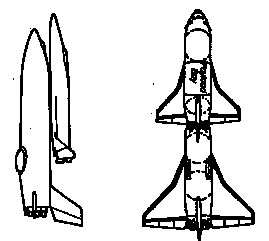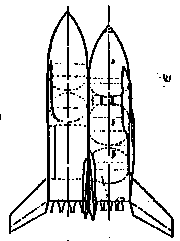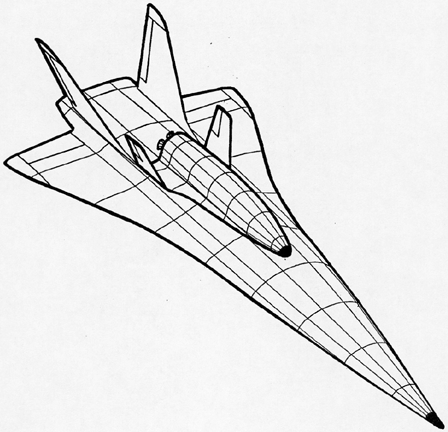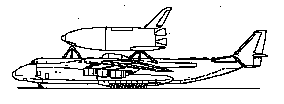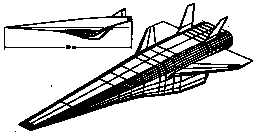ABSTRACT:
It is generally assumed that substantial improvements of technology are required for the next generation of (reusable) launch vehicles. However, this is not necessarily true, even though technology development programs have been performed or started in Europe ( S�nger , FESTIP, FLTP, Astra), the USA (NASP-, X-33
, FESTIP, FLTP, Astra), the USA (NASP-, X-33 -, X-34
-, X-34 -, SLI-Programs) and Japan. The new technologies required depend very much on the launch VEHICLE CONCEPT envisioned. Therefore, an early assessment and selection of an RLV
-, SLI-Programs) and Japan. The new technologies required depend very much on the launch VEHICLE CONCEPT envisioned. Therefore, an early assessment and selection of an RLV System is required. There are simple and cost-effective reusable launch systems which can be built with presently existing technology (such as the Kistler
System is required. There are simple and cost-effective reusable launch systems which can be built with presently existing technology (such as the Kistler K-1 which is under development); and there are highly complex winged RLV
K-1 which is under development); and there are highly complex winged RLV concepts with combined propulsion requiring a host of new technologies. In this case it is even questionable whether such systems will be cost-efficient at all. The tremendous difference of potential launch vehicle system concepts and the required new technologies do not only have a dramatic effect on development cost and time schedule but also on the later operability (risk and reliability) as well as on the finally achievable reduction of transportation cost into space.
concepts with combined propulsion requiring a host of new technologies. In this case it is even questionable whether such systems will be cost-efficient at all. The tremendous difference of potential launch vehicle system concepts and the required new technologies do not only have a dramatic effect on development cost and time schedule but also on the later operability (risk and reliability) as well as on the finally achievable reduction of transportation cost into space.
1. Principles and Trends
The majority of present launch vehicles have been derived from military missile projects where costs and economics have not been an important criteria. Launch capability and national prestige were the main drivers.
However, things have changed: Launch services have become a commercial business where cost and economics are the major factors, amplified by international competition. This requires an open information policy and customer service which apparently represents a difficulty for developing countries which - on the other hand - do have a cost/price advantage.
However, the cost advantage of those traditional expendable launch vehicles will disappear as soon as reusable launch systems become operational. Reusable launch systems are expensive to development, however, they provide a number of advantages in comparison to expendable launchers:
- a major reduction of transportation cost to orbit,
- potential payload (and/or junk) return capability from orbit,
- inherently higher flight reliability (by higher reduncdancy and automatic health control systems),
and
- less environmental pollution, no danger of impacting stages.
From the very principle it also seems economically unacceptable (a waste of resouces) to use a vehicle of 50 to 100 Mio.$ value for one single flight of only 10 to 15 minutes duration. Alone the idea of using, by example, a B.747 aircraft for one single flight only shows how absurd the present situation in the space launch business is.
The development of a new reusable launch vehicle is a major effort and requires a high-level decision and appropriate funding. Since there are many vehicle concept options (which all have already been studied repeatedly) a decision in favour of one preferred RLV Concept apparently is difficult to make. It is far easier to resort to another "Technology Program" as demonstrated in the USA and Europe. Such technology programs can be very useful, however, they can also be a waste of money and time. In Japan the situation is somewhat different: an RLV
Concept apparently is difficult to make. It is far easier to resort to another "Technology Program" as demonstrated in the USA and Europe. Such technology programs can be very useful, however, they can also be a waste of money and time. In Japan the situation is somewhat different: an RLV concept selection has been made by a National Commisssion before the reorientation of the technology development activities was initiated in the year 2000.
concept selection has been made by a National Commisssion before the reorientation of the technology development activities was initiated in the year 2000.
2. Vehicle Concepts and Technology Requirements
It is recognized generally that the related technology must be available at the start of a dedicated vehicle development programme in order to reduce the technical and financial risk. However, a dedicated, effective technology development is only feasible after a decision on the vehicle configuration has been made. Otherweise the risk is large that a good share of the funding is waisted in unnessary activities. The development of Carbon-Composite hydrogen tanks for the X-33 vehicle, by example, has been proven as an unnecessary risk and cost item. Conventional aluminum tanks are doing the purpose at the same weight in this case.
vehicle, by example, has been proven as an unnecessary risk and cost item. Conventional aluminum tanks are doing the purpose at the same weight in this case.
The range of technologies for potential future RLVs represents a very large spectrum, defined by the variety of potential vehicle systems. These are listed here in sequence of increasing technological complexity (FIGs.1 to 4).
FIG.1: Ballistic
VTOL
Launch Vehicle Concepts (
Kankoh Maru
,
BETA
, K-1)
- Ballistic SSTO
 Vehicles ( VTOL
Vehicles ( VTOL ), such as the MDA "Delta Clipper
), such as the MDA "Delta Clipper ",the Beta
",the Beta -Family and " Kankoh Maru
-Family and " Kankoh Maru "
" - Ballistic TSTO
 Vehicles (VTO), such as the Kistler
Vehicles (VTO), such as the Kistler K-1 Vehicle or the "Neptune"-Concept
K-1 Vehicle or the "Neptune"-Concept - Winged SSTO
 Vehicles with Rocket Propulsion (VTO), such as FSSC-1 and the LMC "Venture Star
Vehicles with Rocket Propulsion (VTO), such as FSSC-1 and the LMC "Venture Star " as Lifting Body-
" as Lifting Body- - Winged TSTO
 Vehicles with Rocket Propulsion (VTO) with parallel or tandem staging;
Vehicles with Rocket Propulsion (VTO) with parallel or tandem staging; - Winged TSTO
 Vehicles with Airbreathing Propulsion in the First Stage and Rocket-propelled Second Stage (HTO) such as the German SAENGER
Vehicles with Airbreathing Propulsion in the First Stage and Rocket-propelled Second Stage (HTO) such as the German SAENGER Concept and the Boeing
Concept and the Boeing " Beta
" Beta "
" - Aerospace Plane ( SSTO
 ) with Scramjet-Rocket Propulsion
) with Scramjet-Rocket Propulsion
FIG.2 : Winged VTO/HL-Launch Vehicle Concepts (Rocket Propulsion)
In addition to the basic vehicle concept options there is the controversial case of Single-Stage-to-Orbit ( SSTO ) vs. Two-Stage-to-Orbit ( TSTO
) vs. Two-Stage-to-Orbit ( TSTO ) vehicles to Low Earth orbit ( LEO
) vehicles to Low Earth orbit ( LEO ). It has been stated repeatedly that two-stage vehicles are less demanding with respect to technology than SSTOs. This is not correct: any second stage with orbital capability and re-entry/landing requirement needs exactly the same technology as a single-stage vehicle of the same configuration. True is that a TSTO
). It has been stated repeatedly that two-stage vehicles are less demanding with respect to technology than SSTOs. This is not correct: any second stage with orbital capability and re-entry/landing requirement needs exactly the same technology as a single-stage vehicle of the same configuration. True is that a TSTO vehicle normally has a lower launch mass (and size) than a single-stage RLV
vehicle normally has a lower launch mass (and size) than a single-stage RLV with the same LEO
with the same LEO payload. Size, however, is NOT a major cost driver, but two stages plus pre-flight integration and in-flight stage separation, plus fly-back of the first stage are a great incease of complexity and cost.
payload. Size, however, is NOT a major cost driver, but two stages plus pre-flight integration and in-flight stage separation, plus fly-back of the first stage are a great incease of complexity and cost.
FIG.3 : Two-Stage Launch Vehicles with Airbreathing First Stage (S�NGER with Mach 6.7 First Stage and AN 225 +
HOTOL
)
The discussion of SSTO vs. TSTO
vs. TSTO , however, is more or less obsolete since most missions go beyond LEO
, however, is more or less obsolete since most missions go beyond LEO and equire an additional stage anyhow. Therefore, the technical vehicle design options in reality are:
and equire an additional stage anyhow. Therefore, the technical vehicle design options in reality are:
- FIRST STAGE as low-speed booster
-- with fly-back or glide-back capability to the launch site
(range <> - FIRST STAGE with high-speed capability (i.e. Mach 7)
-- with turbojet engines for cruise flight back to the launch site
(range > 1000 km) - FIRST STAGE with orbital speed capability (Mach 25) and with return to the launch site after re-entry
FIG.4 : Aerospace Plane Concepts with Scramjet/Rocket Propulsion
The SECOND STAGE required for options (1) and (2) can be either
- an expendable stage or propulsion module,
- a reusable Ballistic Stage Vehicle with vertical landing,
- a winged vehicle (similar externally to the Shuttle Orbiter) with horizontal landing.
Size and technology demands are very high - almost the same as SSTO vehicles - for First Stage Concept (1), and less for Concept (2).
vehicles - for First Stage Concept (1), and less for Concept (2).
SEMI-REUSABLE vehicle concepts, such as one or two Flyback-Vehicles attached to an expendable core vehice, have not yet been able to prove their economic viability. The development cost of the reusable vehicle are high, while the expendable stage does not allow to achieve the desired essential Cost-per-Flight reduction.
Avoiding the complexity and different design requirements of a SUBORBITAL STAGE (i.e. flyback aircraft cruising ) is both a cost advantage as well as an operational simplification. Therefore, the ORBITAL capability first stage is preferable -- even though this does lead to a larger-size vehicle - as long as the dimensions are acceptable from a practical standpoint. Advanced structure materials can reduce the vehicle size, but this does normally NOT result in lower costs.
The famous "Aerospace Plane"- SSTO with combined rocket-scramjet-rocket propulsion and a record number of technologies to be developed, has even questionable economics: the large vehivle dry mass to be placed into orbit is a major cost driver.
with combined rocket-scramjet-rocket propulsion and a record number of technologies to be developed, has even questionable economics: the large vehivle dry mass to be placed into orbit is a major cost driver.
It is an often-found misunderstanding and anachronism to seek a vehicle with minimum size/maximum performance. This is the old performance-based paradigm which is no longer applicable for a commercial space transportation business. It simply is too expensive.
The basic ground rule for a future RLV must be to conceive the most simple system for reasons of minimum development cost and operational simplicity/reliability.
must be to conceive the most simple system for reasons of minimum development cost and operational simplicity/reliability.
Any new technology means additional cost and higher risk. This is valid especially if new technology means higher complexity:a negative example in this sense is, by example, the suggestions for tri-propellant rocket engines where a 3 % performance gain is payed for by a 50% increase in the propellant system components and complexity. The much better solution is to increase the size of the bipropellant system by 3 % at almost no cost.
Another example is air collection and liquifaction for oxygen production during cruise flight of the first stage. In this case the simple and cheap oxygen is replaced by a complex machinery.
In TABLE I all dedicated critical technologies techniques and problems are listed which are associated with the various RLV Concepts on page 2 . It becomes clear that a great difference exists between the vehicle concepts - with resulting differences in development costs. Two-stage to LEO
Concepts on page 2 . It becomes clear that a great difference exists between the vehicle concepts - with resulting differences in development costs. Two-stage to LEO -Vehicles imply not only the development of two different systems, but in addition the problems of control dynamics and aerodynamics of the combined system in the initial ascent phase - with subsequent stage separation. It is repeated here that the second stage of TSTO
-Vehicles imply not only the development of two different systems, but in addition the problems of control dynamics and aerodynamics of the combined system in the initial ascent phase - with subsequent stage separation. It is repeated here that the second stage of TSTO systems require exactly the same technologies as a single-stage vehicle.
systems require exactly the same technologies as a single-stage vehicle.
According to TABLE I there is a factor 7 difference between a ballistic SSTO rocket vehicle and a HTOL
rocket vehicle and a HTOL airbreathing scramjet SSTO
airbreathing scramjet SSTO . About the same difference applies to the development costs.
. About the same difference applies to the development costs.
TABLE I : Technologies, Techniques and Problems of the Different
RLV
Concepts
|
| TECHNOLOGY | 1 and 2 | 3 and 4 | 5 | 6 |
| | BALLISTIC | WINGED | AB-- TSTO | AB-- SSTO |
|
| CFK CRYO TANK | @ | @ | @ | @ | @ | @ |
| TPS MET.MULTIWALL | @ | @ | @ | @ | @ | @ |
| HOT WING STRUCTURE | . | . | @ | @ | @ | @ |
| CFC CONTROL PANELS | . | . | @ | @ | @ | @ |
| SiC-PANELS | . | . | . | . | . | @ |
| Ti/CC-MATRIX STRUCTURE | . | . | . | . | . | @@ |
| FUEL CELL POWER SYSTEM | . | . | @ | @ | @ | @ |
| HOT ACTUATORS | . | . | . | . | . | @ |
| AIR DATA SYSTEM | . | . | @ | @ | @ | @ |
LH2 -COOLED STRUCTURE -COOLED STRUCTURE | . | . | . | . | . | @@ |
| SLUSH HYDROGEN TECHNOLOGY | . | . | . | . | . | @ |
| CFD TECHNIQUES | . | . | @ | @ | @ | @ |
| STAGE SEPARATION | . | @ | . | @ | @ | . |
| COMB. CONTROL & AERODYNAMICS | . | @ | . | @ | @ | . |
| ADVANCED AVIONICS | . | . | . | . | . | @ |
| FLYBACK-(CRUISE) PROV. | . | @ | . | @ | @ | . |
| VERTICAL LANDING PROV. | @ | @ | . | . | . | . |
| HIGH-PRESS.ROCKET ENGINES | . | . | @ | @ | @ | @ |
| VARIABLE AIR INTAKE/NOZZLES | . | . | . | . | @ | @@ |
| SCRAMJET PROPULSION | . | . | . | . | . | @@ |
| TURBO/RAMJET PROPULSION | . | . | . | . | @ | . |
| AIR-EJECTOR ROCKET ENGINES | . | . | . | . | . | @ |
|
| TOTAL No. | 3 | 6 | 8 | 11 | 13 | 21 |
|
3. Conclusions
The development effort required for a Reusable Launch Vehicle System ( RLV ) is very much dependent on the vehicle concept selected. The development cost can range from 2 Billion USD as a commercial venture to some 20 Billion USD or more as a "Business-as-Usual" (BaU) governmental program.
) is very much dependent on the vehicle concept selected. The development cost can range from 2 Billion USD as a commercial venture to some 20 Billion USD or more as a "Business-as-Usual" (BaU) governmental program.
Therefore, a major decision is required at the beginning about the purpose of the RLV -Program:
-Program:
- to support technology development and demonstrate "technological leadership" (national prestige) or
- to create a low-cost space transportation system.
Here the interests of industry and Government are not necessarily the same which causes conflicts and delays decisions.
The compromise of a "multi-purpose vehicle" (such as the Space Shuttle) needs high development cost and is expensive to operate. Therefore, the initial vehicle concept decision decides already about the development cost bracket and the operational economics.
REFERENCES:
- D E Koelle
 , 2000, " Handbook of Cost Engineering for Space Transportation Systems
, 2000, " Handbook of Cost Engineering for Space Transportation Systems ", with TRANSCOST-Model 7.0, 224 pages, Report TCS-TR-168(2000), TCS-TransCostSystems
", with TRANSCOST-Model 7.0, 224 pages, Report TCS-TR-168(2000), TCS-TransCostSystems - I Bekey
 , January 1994, " Why SSTO Rocket Launch Vehicles are now Feasible and Practical - A White Paper
, January 1994, " Why SSTO Rocket Launch Vehicles are now Feasible and Practical - A White Paper ", NASA
", NASA Hq.
Hq. - D E Koelle
 , 1997, " Cost Engineering - The New Paradigm for Launch Vehicle Design
, 1997, " Cost Engineering - The New Paradigm for Launch Vehicle Design ", Paper IAF
", Paper IAF -97-IAA
-97-IAA .1.1.04, IAF
.1.1.04, IAF -Congress Torino 1997
-Congress Torino 1997



































